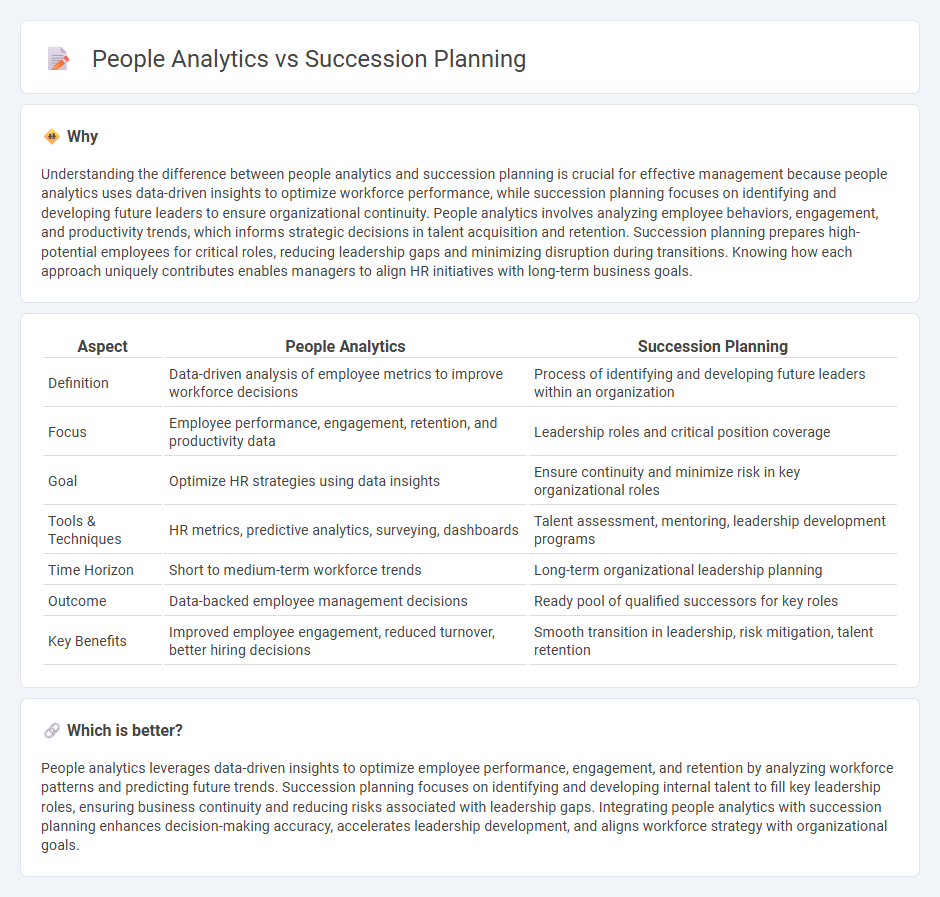
People analytics leverages data-driven insights to optimize talent management, employee performance, and workforce engagement, enhancing decision-making across organizations. Succession planning focuses on identifying and developing future leaders to ensure business continuity and leadership stability. Explore how integrating people analytics with succession planning can transform your management strategy.
Why it is important
Understanding the difference between people analytics and succession planning is crucial for effective management because people analytics uses data-driven insights to optimize workforce performance, while succession planning focuses on identifying and developing future leaders to ensure organizational continuity. People analytics involves analyzing employee behaviors, engagement, and productivity trends, which informs strategic decisions in talent acquisition and retention. Succession planning prepares high-potential employees for critical roles, reducing leadership gaps and minimizing disruption during transitions. Knowing how each approach uniquely contributes enables managers to align HR initiatives with long-term business goals.
Comparison Table
| Aspect | People Analytics | Succession Planning |
|---|---|---|
| Definition | Data-driven analysis of employee metrics to improve workforce decisions | Process of identifying and developing future leaders within an organization |
| Focus | Employee performance, engagement, retention, and productivity data | Leadership roles and critical position coverage |
| Goal | Optimize HR strategies using data insights | Ensure continuity and minimize risk in key organizational roles |
| Tools & Techniques | HR metrics, predictive analytics, surveying, dashboards | Talent assessment, mentoring, leadership development programs |
| Time Horizon | Short to medium-term workforce trends | Long-term organizational leadership planning |
| Outcome | Data-backed employee management decisions | Ready pool of qualified successors for key roles |
| Key Benefits | Improved employee engagement, reduced turnover, better hiring decisions | Smooth transition in leadership, risk mitigation, talent retention |
Which is better?
People analytics leverages data-driven insights to optimize employee performance, engagement, and retention by analyzing workforce patterns and predicting future trends. Succession planning focuses on identifying and developing internal talent to fill key leadership roles, ensuring business continuity and reducing risks associated with leadership gaps. Integrating people analytics with succession planning enhances decision-making accuracy, accelerates leadership development, and aligns workforce strategy with organizational goals.
Connection
People analytics enhances succession planning by leveraging data-driven insights to identify high-potential employees and predict future leadership needs. Integrating workforce metrics such as performance trends, skills assessments, and employee engagement allows managers to create targeted development programs aligned with organizational goals. This synergy improves talent retention, ensures seamless leadership transitions, and supports strategic human capital management.
Key Terms
Talent Pipeline
Succession planning strategically identifies and develops high-potential employees to ensure a robust talent pipeline for future leadership roles. People analytics leverages data-driven insights to predict workforce trends, assess employee performance, and optimize talent development initiatives. Explore how integrating succession planning with people analytics strengthens your talent pipeline and drives organizational growth.
Predictive Analytics
Succession planning relies heavily on predictive analytics to forecast leadership needs and identify potential talent gaps within organizations. People analytics enhances this process by leveraging data-driven insights on employee performance, engagement, and turnover risks to improve decision-making accuracy. Explore how integrating predictive people analytics can revolutionize your succession strategy and future-proof your workforce.
Leadership Development
Succession planning identifies and prepares high-potential leaders to fill key organizational roles, ensuring leadership continuity and reducing talent gaps in critical positions. People analytics leverages data-driven insights to assess leadership competencies, predict future performance, and tailor development programs for emerging leaders, enhancing decision-making precision. Explore how integrating succession planning with people analytics can transform leadership development strategies.
Source and External Links
Succession Planning: All You Need To Know [2025 Edition] - AIHR - Succession planning is the process of selecting and developing key talent to ensure the continuity of critical roles, involving steps like creating a succession chart, identifying key positions, and assessing current talent to prepare future leaders.
Succession Planning: 7-Step Guide & Template - Paylocity - Succession planning is a long-term strategy to identify and prepare employees to replace key roles, ensuring smooth transitions and business continuity through inclusive and transparent development processes.
Succession planning - Wikipedia - Succession planning is a strategy for identifying and developing potential new leaders to fill key hierarchical positions, widely used in businesses and family firms to manage leadership transitions smoothly with the help of advisors when necessary.
 dowidth.com
dowidth.com